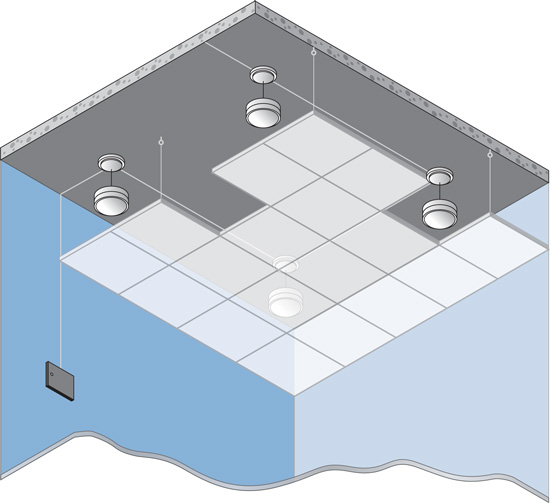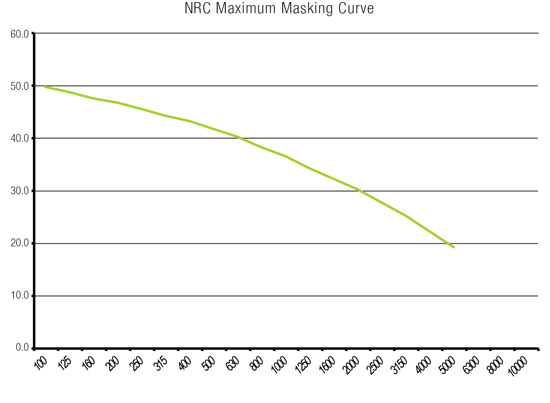Sound Masking 101
White and Pink Noise
Though the term ‘white noise’ still tends to be used interchangeably with ‘sound masking,’ it is a very different type of sound from that produced by modern masking technologies.
White noise is a random broadband sound—meaning it includes a wide range of frequencies—that typically spans the audible range of 20 to 20,000 hertz (Hz). Graphical representations of this type of noise vary depending on the horizontal axis. If it shows individual frequencies, volume is constant; however, if the scale is in octaves, each octave’s volume increases by three decibels (dB) because each octave contains double the number of frequencies than the one before it, and as a general rule, the combined volume of any two sounds of equal volume is three dB higher. Thus, a graph depicting white noise shows either flat or increasing volume.
Most people describe white noise as ‘static’ with an uncomfortable, hissing quality. Those old enough to remember analog televisions compare it to the ‘snow’ broadcast when the antenna lost the transmission signal and picked up electromagnetic noise instead. It is unsurprising that these early masking systems were typically turned down or off soon after they were installed.
‘Pink noise’ is another term often inaccurately substituted for ‘sound masking.’ It is also a random broadband sound, but instead of being equal in volume at each frequency, volume decreases at a rate of three dB per octave as frequency increases. However, because these decreases are offset by the increases created by the doubling of frequencies in each octave, pink noise is constant in volume per octave. Subjectively speaking, this sound is less hissy than white noise. On the other hand, the relatively louder low frequencies give it a rumbling quality, prompting comparisons to the sound of a waterfall.
Given these descriptions, it is understandable why modern sound masking systems do not emit white or pink noise, or in fact any of the other colors (e.g. brown, blue or purple).
A Sound Masking Spectrum
A sound masking spectrum—often called a ‘curve’—is engineered to balance effective acoustic control and comfort. It is usually provided by an acoustician or an independent party, such as the National Research Council (NRC), rather than by the masking vendor.

Image courtesy of Screen Solutions
A sound masking system consists of a series of loudspeakers, which distribute an engineered background sound throughout a facility. The loudspeakers can be installed above a suspended ceiling (as shown) or in an open ceiling.
A masking curve includes a wide range of randomly generated frequencies; however, it is narrower than the full audible range—typically from at least 100 to 5,000 Hz, and sometimes as high as 10,000 Hz. Further, the volume of masking frequencies is not equal, nor do they decrease at a constant rate as frequency increases.
It is important to understand that the curve defines what the sound masking system’s measured output should be within the space. Regardless of how the system is designed, its out-of-the-box settings, or the orientation of its loudspeakers (i.e. upward- or downward-facing, sometimes called ‘direct-field’), the sound is influenced as it interacts with various interior elements within the facility, such as the layout and furnishings. If the sound is to meet the specified curve, the system’s volume and frequency settings have to be adjusted in small, localized zones. In other words, it must be tuned for the particular environment in which it is installed.
Tuning is handled by a qualified technician after the ceilings and all furnishings are in place, and with mechanical systems operating at normal daytime levels. Since conversations and activities can prevent accurate measurement, it is done prior to occupation or after hours. Basically, the technician uses a sound level meter to measure the masking sound at ear height. The technician analyzes the results, and adjusts the system’s volume and equalizer controls accordingly. This process is then repeated as often as needed until the desired curve is met at each tuning location.

Image courtesy of NRC
A sound masking spectrum or ‘curve’ is typically specified by an acoustician or supplied by an independent third party, such as the National Research Council (as shown), rather than by the sound masking system’s vendor.
Achieving Spatial Uniformity
Most people compare the sound of a professionally tuned masking system to that of softly blowing air. However, there is much more significance to the tuning process than simply providing a pleasant auditory experience. One must also ensure that the sound performs its intended job.
The effectiveness of the masking sound is directly related to the sound masking system’s ability to closely match the specified curve. Some degree of variation is expected; it is impossible to achieve perfection in every tuning location. However, because variations in the masking sound can profoundly impact performance, the specification should not only provide a target curve, but also a ‘tolerance’ that indicates by how much the sound is allowed to deviate from that curve across the space. Achieving consistency is also important for comfort; a uniform sound fades into the background more easily, and occupants come to consider it a natural part of their space.
Historically, tolerance was often set to ±2 dBA (i.e. plus or minus two A-weighted decibels), giving an overall range of 4 dBA. However, such wide swings in overall volume across the space can allow occupants to understand up to 43 percent more of a conversation in some areas than they can in others. Advances in masking technology now permit tolerance to be set as low as ±0.5 dBA (i.e. a range of 1 dBA), yielding far more consistent results and providing dependable masking coverage throughout the installation.









